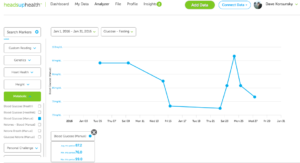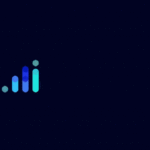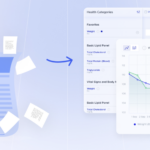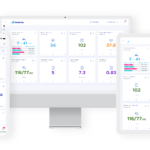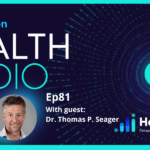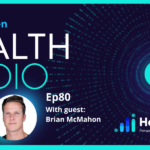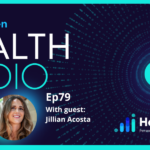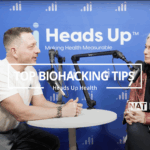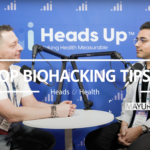At the start of 2016, I decided to resume my own n=1 experiment on the ketogenic diet. I’d tested this diet briefly back in October 2015 and had some encouraging results. Most notably, I lost weight, my fasting blood sugar came down, I had incredible amounts of energy and my mental acuity and performance felt better than ever. Simply put, my first experience with ketosis was the best I’ve felt in years. I wanted more!
Therefore, as of the beginning of this year, I’ve been focused on getting back into a state of nutritional ketosis. I’ll be sharing my results over the course of the experiment here on the blog. All my data – from blood sugar levels to lab test results – is tracked in the Heads Up Health app. If you’d like to get started doing the same, click the link below.
[maxbutton id=”4″]
Blood Sugar
The first interesting observation is the change in my fasting blood sugar(i). To induce a state of nutritional ketosis I had been limiting my carbohydrate intake to 5% of my total calories per day (about 20 grams of total carbs daily). Not surprisingly, my fasting blood sugar plummeted (click to enlarge image):
Observations from this graph:
- My fasting sugar dropped from 96 mg/dL down to 81 mg/dL by the end of the month. At one point it even dipped down into the high 70’s. For those looking to control blood sugar, the ketogenic diet is certainly highly effective here.
- There was one spike at 99 mg/dL on Jan 24th. I checked my nutrition logs and sure enough I had consumed a good handful of refined carbs the night before when I was out for dinner with friends.
- Fasting sugar came back down for the remainder of the month as I got back onto a disciplined ketogenic diet
Weight
I’ve been tracking weight(ii) regularly and have been looking forward to dropping some unwanted body fat over the course of the experiment. One of the benefits of nutritional ketosis is the weight loss that comes with it as your body begins to burn fat for fuel. Taking a look at my weight readings, I was pleased with the results (click the graph to enlarge):
Observations from this graph:
- My weight dropped from 197.2 pounds to 192.6 pounds which is a respectable 4.6 pounds lost in the month.
- This just over one pound lost per week, which is about right for ketosis based on my early understanding of the diet.
- Fluid loss can account for about 5-10% of the initial weight loss on keto. Therefore, it will be important to keep an eye on the scale over time as my body’s fluid levels normalize.
- I’ve also graphed fasting blood sugar on the graph along with weight. The two appear to be correlated based on these early measurements.
Body fat percentage
Equally, if not more important than weight is body fat percentage(iii). Even if my weight is increasing, as long as body fat percentage is going down, I know that I am losing fat and my overall body composition is improving:
Observations from this graph:
- Body fat percentage came down over the course of the month from 24.2% to 22.9% and followed a similar trend to the loss in weight.
[maxbutton id=”2″]
What’s Going on Here?
This is the outcome I was hoping to see in the early days of the experiment. As my body makes the switch from burning glucose (i.e. carbs) to burning fat (i.e. ketones) for fuel, my blood sugar is coming down and so are my weight and my body fat percentage readings.
As a beginner on Keto, one of the first books I read was called Keto Clarity by Jimmy Moore. This is where I learned about the connection between insulin and weight gain. My take away as a beginner was that the best way to think about losing weight is not to focus on restricting calories, but instead think about trying to restrict your body’s insulin response. The best way to limit insulin release is to limit foods that will spike your blood sugar. Diets like Paleo and Ketogenic are excellent for lowering blood sugar as they replace the foods that spike blood sugar (refined carbs, grains, fruits etc.) with calories from healthy fats that keep blood sugar low yet keep you feeling full and satiated.
Additionally, the weight and body fat loss may be attributed to my body starting to burn fat for fuel instead of glucose, which is one of the many benefits of the ketogenic diet. I also noticed that as my ketone levels increased, my appetite decreased. Ketones are known to act as a a natural appetite suppressant and I found that over the course of the month, I had less food cravings and needed to eat less food in order to feel full.
Still lots to learn but I am very encouraged about my initial experience and intrigued about going deeper into a ketogenic lifestyle.
Up Next
- As of February 1st I’ve also started tracking blood ketones(iv) and will share this data next month
- I will also attempt to obtain a new set of lab tests in February so I can get a sense of what’s happening with my lipid panel and blood sugar markers. I will share this data as soon as I have it.
Thanks for reading. I’d love to hear your thoughts on the above. If you want to track your own health metrics using Heads Up Health, click below to get started.
[maxbutton id=”4″]
Appendix
(i) Blood sugar is being tracked using the Bayer Contour glucometer. I like this meter because the finger lancet is less painful compared to other meters I’ve used.
(ii)(iii) Weight and body fat percentage are being tracked using the Tanita BF679W scale. I like this scale because it’s reasonably priced (50 bucks) and very accurate. I’ve compared the results on this scale to results from an expensive DXA scan and the results typically vary by only 1-2 pounds.
(iv) I am tracking blood ketones using the Precision Xtra blood ketone meter.

